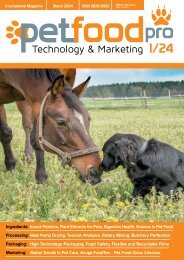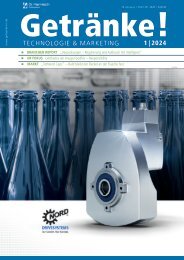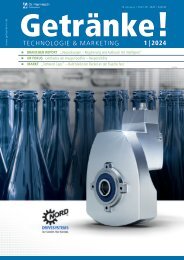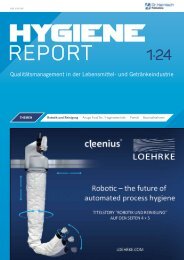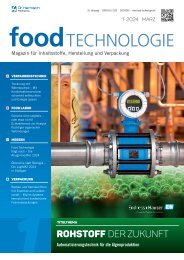Wellness Foods + Supplements 1/2022
Wellness Foods & Supplements is the first European magazine devoted exclusively to health ingredients, nutraceutical foods and beverages. Questions about the trade magazine Wellness Foods & Supplements? Interested in subscribing or advertising? The board of editors at Wellness Foods & Supplements kindly remains at your disposal.
Wellness Foods & Supplements is the first European magazine devoted exclusively to health ingredients, nutraceutical foods and beverages.
Questions about the trade magazine Wellness Foods & Supplements? Interested in subscribing or advertising? The board of editors at Wellness Foods & Supplements kindly remains at your disposal.
You also want an ePaper? Increase the reach of your titles
YUMPU automatically turns print PDFs into web optimized ePapers that Google loves.
Antioxidants in baked goods<br />
three phases (initiation with formation of<br />
free radicals, propagation and finally termination<br />
with formation of non-radical products).<br />
Whereas the Maillard reaction and<br />
caramelisation need high activation energy<br />
and thus mainly occur during thermal treatments,<br />
lipid oxidation requires low energy<br />
along with oxygen.<br />
Fats impart taste and texture to the product<br />
but because they susceptible to oxidation<br />
leading to the development of rancidity and<br />
off-flavour through the autooxidation or lipid<br />
oxidation reactions, additives, such as antioxidants<br />
are also added to the mixture.<br />
Antioxidants have become an indispensable<br />
group of food additives mainly because<br />
of their unique properties of enhancing<br />
the shelf life of food products without any<br />
damage to sensory or nutritional qualities.<br />
Concerns about the safety of synthetic antioxidants<br />
have given rise to a large body of<br />
research on natural sources of antioxidants.<br />
Natural antioxidants allow food processors<br />
to produce stable products with ‘‘clean’’<br />
labels of all-natural ingredients. They bring<br />
less rigorous burden-of-safety proof than<br />
that required for synthetic products. In addition<br />
to their antioxidant activity, some natural<br />
antioxidants, such as vitamins, minerals,<br />
and enzymes, are also regarded as nutrients<br />
due to their bioactivity.<br />
Tocopherols and tocotrienols, collectively<br />
known as tocols, are monophenolic and lipophilic<br />
compounds that are widely distributed in plant tissues. The<br />
main commercial source of natural tocopherols is the soybean oil.<br />
Tocotrienols, less common than tocopherols, are present in palm oil,<br />
rice bran oil, as well ascereals and legumes. Tocopherols and tocotrienols<br />
are classified into alpha, beta, gamma, delta, depending on<br />
their chemical structures. These eight molecules are part of the group<br />
known as vitamin E.<br />
Tocopherols and tocotrienols are primary antioxidants, which act by<br />
terminating the free-radical chain reaction by donating hydrogen or<br />
electrons to free radicals and converting them to more stable products.<br />
Secondary antioxidants, such as ascorbic acid, citric acid, lecithin<br />
or flavonoids can be also added to the products. Secondary antioxidants<br />
can be broadly classified as oxygen scavengers and chelators.<br />
They have a synergic effect, together with tocopherols, as they<br />
act as hydrogen donors to the tocopheryl radical, thereby regenerating<br />
the primary antioxidant. Hence tocopherols can be used at<br />
lower levels if a synergist is incorporated simultaneously in the food<br />
product.<br />
In order to protect the baked goods from oxidation, antioxidants can<br />
be applied either to the final product, or directly to the oil previous<br />
to the mixing of ingredients. To measure the efficacy of tocopherolbased<br />
antioxidants, accelerated oxidation tests have been performed.<br />
In the first experiment, the Rancimat test was used. It is a simple,<br />
quick an efficient way to screen the effectiveness of antioxidants<br />
used in fats and oils. The method is an accelerated oxidation test in<br />
which the oil or fat to be tested is run at elevated temperatures whilst<br />
exposing the sample to air, accelerating the oxidation process of the<br />
oil. Soybean oil, one of the mayor oils in the baking industry, was<br />
mixed with different tocopherol-based natural antioxidants.<br />
Tocobiol ® is a natural antioxidant made from the distillation of a single<br />
raw ingredient, whole non-GMO soybean oil. It naturally contains<br />
mixed tocopherols, plant sterols, squalene and monoglycerides<br />
which provide its unique antioxidant and dispersibility properties.














